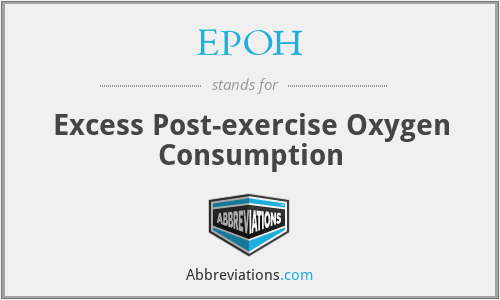What does EPOH mean in Academic & Science?
This page is about the meanings of the acronym/abbreviation/shorthand EPOH in the field in general and in the Academic & Science terminology in particular.
Excess Post-exercise Oxygen Consumption
Submitted by rinat on August 15, 2017
Translation
Find a translation for Excess Post-exercise Oxygen Consumption in other languages:
Select another language:
- - Select -
- 简体中文 (Chinese - Simplified)
- 繁體中文 (Chinese - Traditional)
- Español (Spanish)
- Esperanto (Esperanto)
- 日本語 (Japanese)
- Português (Portuguese)
- Deutsch (German)
- العربية (Arabic)
- Français (French)
- Русский (Russian)
- ಕನ್ನಡ (Kannada)
- 한국어 (Korean)
- עברית (Hebrew)
- Gaeilge (Irish)
- Українська (Ukrainian)
- اردو (Urdu)
- Magyar (Hungarian)
- मानक हिन्दी (Hindi)
- Indonesia (Indonesian)
- Italiano (Italian)
- தமிழ் (Tamil)
- Türkçe (Turkish)
- తెలుగు (Telugu)
- ภาษาไทย (Thai)
- Tiếng Việt (Vietnamese)
- Čeština (Czech)
- Polski (Polish)
- Bahasa Indonesia (Indonesian)
- Românește (Romanian)
- Nederlands (Dutch)
- Ελληνικά (Greek)
- Latinum (Latin)
- Svenska (Swedish)
- Dansk (Danish)
- Suomi (Finnish)
- فارسی (Persian)
- ייִדיש (Yiddish)
- հայերեն (Armenian)
- Norsk (Norwegian)
- English (English)
Definition
What does EPOH mean?
- Excess post-exercise oxygen consumption
- Excess post-exercise oxygen consumption (EPOC, informally called afterburn) is a measurably increased rate of oxygen intake following strenuous activity. In historical contexts the term "oxygen debt" was popularized to explain or perhaps attempt to quantify anaerobic energy expenditure, particularly as regards lactic acid/lactate metabolism; in fact, the term "oxygen debt" is still widely used to this day. However, direct and indirect calorimeter experiments have definitively disproven any association of lactate metabolism as causal to an elevated oxygen uptake.In recovery, oxygen (EPOC) is used in the processes that restore the body to a resting state and adapt it to the exercise just performed. These include: hormone balancing, replenishment of fuel stores, cellular repair, innervation, and anabolism. Post-exercise oxygen consumption replenishes the phosphagen system. New ATP is synthesized and some of this ATP donates phosphate groups to creatine until ATP and creatine levels are back to resting state levels again. Another use of EPOC is to fuel the body’s increased metabolism from the increase in body temperature which occurs during exercise.EPOC is accompanied by an elevated consumption of fuel. In response to exercise, fat stores are broken down and free fatty acids (FFA) are released into the blood stream. In recovery, the direct oxidation of free fatty acids as fuel and the energy consuming re-conversion of FFAs back into fat stores both take place.
Embed
Citation
Use the citation below to add this abbreviation to your bibliography:
Style:MLAChicagoAPA
"EPOH." Abbreviations.com. STANDS4 LLC, 2024. Web. 1 May 2024. <https://www.abbreviations.com/term/1935498>.



Discuss this EPOH abbreviation with the community:
Report Comment
We're doing our best to make sure our content is useful, accurate and safe.
If by any chance you spot an inappropriate comment while navigating through our website please use this form to let us know, and we'll take care of it shortly.
Attachment
You need to be logged in to favorite.
Log In